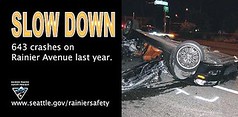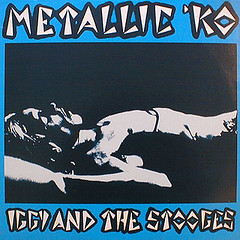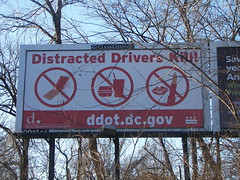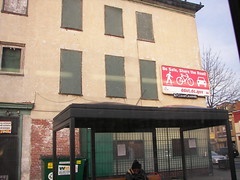Engineering vs. norms

Seattle Dept. of Transportation photo. Billboards showing dramatic crash scenes are being placed on Rainier Avenue South in an effort to get drivers to reduce their speed. The roadway has been the scene of many crashes and car-pedestrian accidents.
A friend-colleague always gets on my case about my "faith" and belief in norms--what people should do--rather than working to appeal to people's most basic needs and desires--self-interest mostly.
There is a story in the Seattle Times, see "Billboards aim to get Rainier Ave. drivers to hit the brakes," about a pedestrian safety campaign targeting drivers, by showing gruesome photos of car accidents.
I was reminded of a line by Iggy Pop from the album Metallic KO, a bootleg of a concert from 1973, and he says "you can throw all the bottles in the world, and your girlfriends will still love me."

You can put up all the billboards in the world, have all the advertising campaigns targeting drivers that you want, but as long as the roads are engineered to accommodate much higher speeds than the posted limits, and much higher speeds than are safe for pedestrian areas, particularly mixed use commercial districts and residential areas, you're going to have pedestrians getting killed, and cars crashing.
It's about the pavement. A good example in Ward 5 is South Dakota Avenue in NE DC. Like most DC streets, the speed limit is 25 mph. But the road is pristine, paved with concrete, few potholes, seemingly beautifully maintained. This road can easily accommodate speeds in excess of 50 mph comfortably. I don't know what the prevailing speed is on the street, it must be close to 40 mph--not 25 mph. It's very dangerous, and likely one of the many reasons you don't see many pedestrians east of 13th Street NE. (n.b. the fact is that much of Ward 5 was designed around automobility, and the residential areas are heavily auto-centric and auto-dependent.)
Again, if you want cars to move more slowly, engineer the roads to yield slower average speeds.
I will say though that the SDOT photo-billboards are more direct than DC's own versions.





0 Comments:
Post a Comment
<< Home